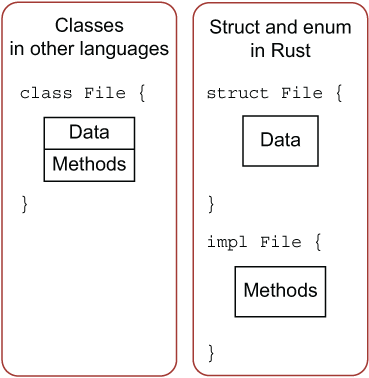方法 Method
从面向对象语言过来的同学对于方法肯定不陌生,class 里面就充斥着方法的概念。在 Rust 中,方法的概念也大差不差,往往和对象成对出现:
#![allow(unused)] fn main() { object.method() }
例如读取一个文件写入缓冲区,如果用函数的写法 read(f, buffer),用方法的写法 f.read(buffer)。不过与其它语言 class 跟方法的联动使用不同(这里可能要修改下),Rust 的方法往往跟结构体、枚举、特征(Trait)一起使用,特征将在后面几章进行介绍。
定义方法
Rust 使用 impl 来定义方法,例如以下代码:
#![allow(unused)] fn main() { struct Circle { x: f64, y: f64, radius: f64, } impl Circle { // new是Circle的关联函数,因为它的第一个参数不是self,且new并不是关键字 // 这种方法往往用于初始化当前结构体的实例 fn new(x: f64, y: f64, radius: f64) -> Circle { Circle { x: x, y: y, radius: radius, } } // Circle的方法,&self表示借用当前的Circle结构体 fn area(&self) -> f64 { std::f64::consts::PI * (self.radius * self.radius) } } }
我们这里先不详细展开讲解,只是先建立对方法定义的大致印象。下面的图片将 Rust 方法定义与其它语言的方法定义做了对比:

可以看出,其它语言中所有定义都在 class 中,但是 Rust 的对象定义和方法定义是分离的,这种数据和使用分离的方式,会给予使用者极高的灵活度。
再来看一个例子:
#[derive(Debug)] struct Rectangle { width: u32, height: u32, } impl Rectangle { fn area(&self) -> u32 { self.width * self.height } } fn main() { let rect1 = Rectangle { width: 30, height: 50 }; println!( "The area of the rectangle is {} square pixels.", rect1.area() ); }
该例子定义了一个 Rectangle 结构体,并且在其上定义了一个 area 方法,用于计算该矩形的面积。
impl Rectangle {} 表示为 Rectangle 实现方法(impl 是实现 implementation 的缩写),这样的写法表明 impl 语句块中的一切都是跟 Rectangle 相关联的。
self、&self 和 &mut self
接下来的内容非常重要,请大家仔细看。在 area 的签名中,我们使用 &self 替代 rectangle: &Rectangle,&self 其实是 self: &Self 的简写(注意大小写)。在一个 impl 块内,Self 指代被实现方法的结构体类型,self 指代此类型的实例,换句话说,self 指代的是 Rectangle 结构体实例,这样的写法会让我们的代码简洁很多,而且非常便于理解:我们为哪个结构体实现方法,那么 self 就是指代哪个结构体的实例。
需要注意的是,self 依然有所有权的概念:
self表示Rectangle的所有权转移到该方法中,这种形式用的较少&self表示该方法对Rectangle的不可变借用&mut self表示可变借用
总之,self 的使用就跟函数参数一样,要严格遵守 Rust 的所有权规则。
回到上面的例子中,选择 &self 的理由跟在函数中使用 &Rectangle 是相同的:我们并不想获取所有权,也无需去改变它,只是希望能够读取结构体中的数据。如果想要在方法中去改变当前的结构体,需要将第一个参数改为 &mut self。仅仅通过使用 self 作为第一个参数来使方法获取实例的所有权是很少见的,这种使用方式往往用于把当前的对象转成另外一个对象时使用,转换完后,就不再关注之前的对象,且可以防止对之前对象的误调用。
简单总结下,使用方法代替函数有以下好处:
- 不用在函数签名中重复书写
self对应的类型 - 代码的组织性和内聚性更强,对于代码维护和阅读来说,好处巨大
方法名跟结构体字段名相同
在 Rust 中,允许方法名跟结构体的字段名相同:
impl Rectangle { fn width(&self) -> bool { self.width > 0 } } fn main() { let rect1 = Rectangle { width: 30, height: 50, }; if rect1.width() { println!("The rectangle has a nonzero width; it is {}", rect1.width); } }
当我们使用 rect1.width() 时,Rust 知道我们调用的是它的方法,如果使用 rect1.width,则是访问它的字段。
一般来说,方法跟字段同名,往往适用于实现 getter 访问器,例如:
mod my { pub struct Rectangle { width: u32, pub height: u32, } impl Rectangle { pub fn new(width: u32, height: u32) -> Self { Rectangle { width, height } } pub fn width(&self) -> u32 { return self.width; } pub fn height(&self) -> u32 { return self.height; } } } fn main() { let rect1 = my::Rectangle::new(30, 50); println!("{}", rect1.width()); // OK println!("{}", rect1.height()); // OK // println!("{}", rect1.width); // Error - the visibility of field defaults to private println!("{}", rect1.height); // OK }
当从模块外部访问结构体时,结构体的字段默认是私有的,其目的是隐藏信息(封装)。我们如果想要从模块外部获取 Rectangle 的字段,只需把它的 new, width 和 height 方法设置为公开可见,那么用户就可以创建一个矩形,同时通过访问器 rect1.width() 和 rect1.height() 方法来获取矩形的宽度和高度。
因为 width 字段是私有的,当用户访问 rect1.width 字段时,就会报错。注意在此例中,Self 指代的就是被实现方法的结构体 Rectangle。
特别的是,这种默认的可见性(私有的)可以通过 pub 进行覆盖,这样对于模块外部来说,就可以直接访问使用 pub 修饰的字段而无需通过访问器。这种可见性仅当从定义结构的模块外部访问时才重要,并且具有隐藏信息(封装)的目的。
->运算符到哪去了?在 C/C++ 语言中,有两个不同的运算符来调用方法:
.直接在对象上调用方法,而->在一个对象的指针上调用方法,这时需要先解引用指针。换句话说,如果object是一个指针,那么object->something()和(*object).something()是一样的。Rust 并没有一个与
->等效的运算符;相反,Rust 有一个叫 自动引用和解引用的功能。方法调用是 Rust 中少数几个拥有这种行为的地方。他是这样工作的:当使用
object.something()调用方法时,Rust 会自动为object添加&(视可见性添加&mut)、*以便使object与方法签名匹配。也就是说,这些代码是等价的:#![allow(unused)] fn main() { #[derive(Debug,Copy,Clone)] struct Point { x: f64, y: f64, } impl Point { fn distance(&self, other: &Point) -> f64 { let x_squared = f64::powi(other.x - self.x, 2); let y_squared = f64::powi(other.y - self.y, 2); f64::sqrt(x_squared + y_squared) } } let p1 = Point { x: 0.0, y: 0.0 }; let p2 = Point { x: 5.0, y: 6.5 }; p1.distance(&p2); (&p1).distance(&p2); }第一行看起来简洁的多。这种自动引用的行为之所以有效,是因为方法有一个明确的接收者————
self的类型。在给出接收者和方法名的前提下,Rust 可以明确地计算出方法是仅仅读取(&self),做出修改(&mut self)或者是获取所有权(self)。事实上,Rust 对方法接收者的隐式借用让所有权在实践中更友好。
带有多个参数的方法
方法和函数一样,可以使用多个参数:
impl Rectangle { fn area(&self) -> u32 { self.width * self.height } fn can_hold(&self, other: &Rectangle) -> bool { self.width > other.width && self.height > other.height } } fn main() { let rect1 = Rectangle { width: 30, height: 50 }; let rect2 = Rectangle { width: 10, height: 40 }; let rect3 = Rectangle { width: 60, height: 45 }; println!("Can rect1 hold rect2? {}", rect1.can_hold(&rect2)); println!("Can rect1 hold rect3? {}", rect1.can_hold(&rect3)); }
关联函数
现在大家可以思考一个问题,如何为一个结构体定义一个构造器方法?也就是接受几个参数,然后构造并返回该结构体的实例。其实答案在开头的代码片段中就给出了,很简单,参数中不包含 self 即可。
这种定义在 impl 中且没有 self 的函数被称之为关联函数: 因为它没有 self,不能用 f.read() 的形式调用,因此它是一个函数而不是方法,它又在 impl 中,与结构体紧密关联,因此称为关联函数。
在之前的代码中,我们已经多次使用过关联函数,例如 String::from,用于创建一个动态字符串。
#![allow(unused)] fn main() { #[derive(Debug)] struct Rectangle { width: u32, height: u32, } impl Rectangle { fn new(w: u32, h: u32) -> Rectangle { Rectangle { width: w, height: h } } } }
Rust 中有一个约定俗成的规则,使用
new来作为构造器的名称,出于设计上的考虑,Rust 特地没有用new作为关键字。
因为是函数,所以不能用 . 的方式来调用,我们需要用 :: 来调用,例如 let sq = Rectangle::new(3, 3);。这个方法位于结构体的命名空间中::: 语法用于关联函数和模块创建的命名空间。
多个 impl 定义
Rust 允许我们为一个结构体定义多个 impl 块,目的是提供更多的灵活性和代码组织性,例如当方法多了后,可以把相关的方法组织在同一个 impl 块中,那么就可以形成多个 impl 块,各自完成一块儿目标:
#![allow(unused)] fn main() { #[derive(Debug)] struct Rectangle { width: u32, height: u32, } impl Rectangle { fn area(&self) -> u32 { self.width * self.height } } impl Rectangle { fn can_hold(&self, other: &Rectangle) -> bool { self.width > other.width && self.height > other.height } } }
当然,就这个例子而言,我们没必要使用两个 impl 块,这里只是为了演示方便。
为枚举实现方法
枚举类型之所以强大,不仅仅在于它好用、可以同一化类型,还在于,我们可以像结构体一样,为枚举实现方法:
#![allow(unused)] enum Message { Quit, Move { x: i32, y: i32 }, Write(String), ChangeColor(i32, i32, i32), } impl Message { fn call(&self) { // 在这里定义方法体 } } fn main() { let m = Message::Write(String::from("hello")); m.call(); }
除了结构体和枚举,我们还能为特征(trait)实现方法,这将在下一章进行讲解,在此之前,先来看看泛型。
课后练习
Rust By Practice,支持代码在线编辑和运行,并提供详细的习题解答。